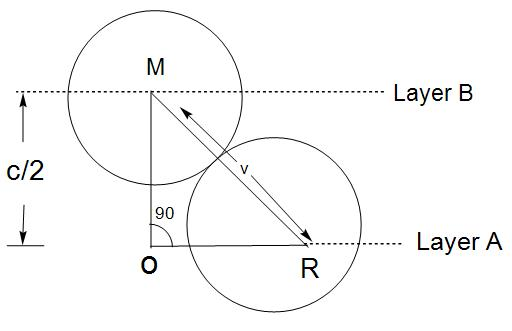
What is the maximum number of layers of atoms in close-packed planes that will lie within two imaginary parallel planes having a distance between them as
[ Consider the atoms to be within the parallel planes if their centres are on or within the two parallel planes.]
Answer
513.9k+ views
Hint: Unit cells are basically the smallest repeating atoms in a crystal. There are different types of unit cell like body centred unit cell represented as BCC, face centred unit cell (FCC). FCC is the face centred cubic unit cell, which is having coordination number 12 and also contains 4 atoms per unit cell.
Complete step by step answer:
- We will first draw the diagram:

- Here, we know that the distance given in between parallel planes is
- Now, by solving this equation we get :
Now, we have to find the height C,
- We can also write this equation as:
- Now, the distance between two layers that is A and B=
- The given distance between two imaginary plane=
Now, let K number of imaginary planes=
Hence, we can conclude that the maximum number of layers of atoms in close-packed planes will be 7.
Note: We must not get confused in terms of FCC and BCC. FCC is face centred cubic unit cell, it contains four atoms per unit cell. Whereas, BCC is a body centred unit cell, it contains 2 atoms per unit cell.
Complete step by step answer:
- We will first draw the diagram:

- Here, we know that the distance given in between parallel planes is
- Now, by solving this equation we get :
Now, we have to find the height C,
- We can also write this equation as:
- Now, the distance between two layers that is A and B=
- The given distance between two imaginary plane=
Now, let K number of imaginary planes=
Hence, we can conclude that the maximum number of layers of atoms in close-packed planes will be 7.
Note: We must not get confused in terms of FCC and BCC. FCC is face centred cubic unit cell, it contains four atoms per unit cell. Whereas, BCC is a body centred unit cell, it contains 2 atoms per unit cell.
Latest Vedantu courses for you
Grade 9 | CBSE | SCHOOL | English
Vedantu 9 CBSE Pro Course - (2025-26)
School Full course for CBSE students
₹37,300 per year
Recently Updated Pages
Master Class 11 Business Studies: Engaging Questions & Answers for Success

Master Class 11 Economics: Engaging Questions & Answers for Success

Master Class 11 Accountancy: Engaging Questions & Answers for Success

Master Class 11 Computer Science: Engaging Questions & Answers for Success

Master Class 11 Maths: Engaging Questions & Answers for Success

Master Class 11 English: Engaging Questions & Answers for Success

Trending doubts
Which one is a true fish A Jellyfish B Starfish C Dogfish class 11 biology CBSE

Difference Between Prokaryotic Cells and Eukaryotic Cells

1 ton equals to A 100 kg B 1000 kg C 10 kg D 10000 class 11 physics CBSE

One Metric ton is equal to kg A 10000 B 1000 C 100 class 11 physics CBSE

1 Quintal is equal to a 110 kg b 10 kg c 100kg d 1000 class 11 physics CBSE

Net gain of ATP in glycolysis a 6 b 2 c 4 d 8 class 11 biology CBSE




